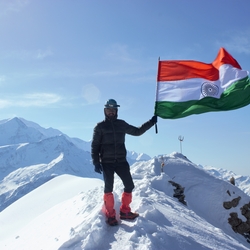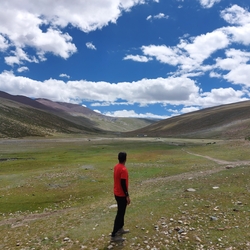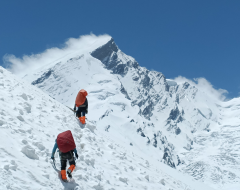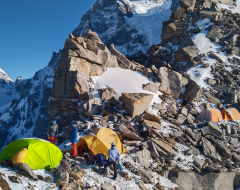For the first time in a week since the start of the Kalindi Khal Expedition, genial merriment permeated the blanket of gloom that had enveloped the campsite of Nandanvan.
Settling down on a floor rumpled with boulders, Kulwinder, one of our participants had cheerfully begun singing a song. Sandeep and Somenath, our Expedition Leaders, soon joined in along with the others.
The past week had been anything but easy for them. Trouble had decided to strike our month’s long hard work from all directions at once.
From permits getting delayed to porters abandoning the trail midway, today’s story is about the grit of a team that made it through one of India’s toughest expeditions despite all odds.
This is Part 2 of the Story.
Part 1 can be found here.
20th September
Recharged from the positive turn of events the previous day, the team woke up to a bright, amiable morning blessed with clear views all around.
Today, they were going to be crossing the relentless Chaturangi glacier.
“A lot of people don’t know this, but on the Kalindi Khal expedition, one gets to cross not one or two but 8 humongous glaciers through the duration of the trek. This means there will be a glacier crossing almost every other day on the trail! This is one of the most demanding aspects of the trek”- Sandeep
The team’s campsite for the day was the Vasuki Tal.
“50% of the trail was good, the rest not so much. But the views were amazing, thanks to the clear weather. We started our trek at 10 in the morning that day and estimated it would take 6 hours to reach the Vasuki Tal Campsite” – Somenath
The Chaturangi glacier was not the only daunting stretch awaiting the team that day, though. After the glacier, there is a steep ascent that leads to an almost 90-degree vertical wall climb beyond which lies the much-acclaimed campsite of Vasuki Tal.
“By the time we reached the gully/wall that stood before the Vasuki Tal Campsite, the weather had turned moody. The temperatures had dipped, the skies had become cloudy and a chilly wind had picked up pace around us.”- Sandeep

The team making their way to the gully before the Vasuki Tal Campsite. PC: Somenath
Navigating this stretch with 16 porters, the load and trekkers was not going to be an easy task.
“We cleared the rocks on the route and set up the ropes for belaying. Sandeep went first and waited at the top of the gully. Rohit (former Expedition Leader at Bikat Adventures) stayed in the middle of the gully. Lalit (former Trek Leader at Bikat Adventures) and I stayed at the bottom to assist the team”- Somenath
By this time, a light snowfall had begun. But what really knackered everyone was the strong cold winds that pierced through their wind jackets as they made their painfully slow but steady climb up the vertical gully.
"The gully took us three hours to navigate. It would have taken lesser time had the weather been more favorable. We reached the campsite a little past sunset. I was feeling a little feverish because I had stayed at the top for long in the cold winds. After gulping down some hot food, we drifted off to sleep immediately because all of us were exhausted that day” – Sandeep

21st September
According to the itinerary, today was supposed to be a rest day. Since the team had lost a fairly crucial time at the beginning of the trek, they decided to skip the rest day and head to the next campsite.
“The next campsite, Khara Patthar, was visible from Vasuki Tal. It didn’t look very far from where we stood. But, knowing how deceptive distances can be in the mountains, we aimed for an early start in the morning.” – Somenath
It was going to be a tough day. The Khara Patthar campsite is situated right on a glacier. This means the entire trail was going to involve tricky glacier crossings.
“The weather was clear but there was not much to look forward to in terms of views. The terrain all the way to Khara Patthar was covered in the moraine. The only highlight, apart from the challenge of crossing the glacier, was the beautiful views one could get of Mt. Satopanth on the way and all the way” – Somenath

On the way to Khara Patthar Campsite. PC: Somenath
“The team began their hike to Khara Patthar at 9 in the morning. I started a little later with the rest of the porters. As I mentioned earlier, we were not trekking with Bikat Adventures’ usual team of porters from Nepal.
Covid virus, the subsequent lockdown and opening up of the borders in phases had forced us to employ a new, unfamiliar team (temporarily) from Uttarakhand.
Trekking with the porters allowed me a glimpse into how they worked internally. It explained all the disorganisation and lack of co-ordination in their activities over the last few days. Every porter’s group has a head porter, a person who decides the route, the load distribution, the time they start from the campsite, the pace they maintain etc
This team of porters accompanying us on the Kalindi Khal lacked one such command. As a result, just on that one day to Khara Patthar, the porters had split into groups of two or three and headed off in different directions with their loads. We had to wait and regroup multiple times on the way and ended up reaching the camp site quite late” – Sandeep
22nd September
The team was going to be trekking from Khara Patthar to Sweta Glacier today.
“The terrain wasn’t friendly. We were going to be traversing through rock fall zones. Of all the campsites, the Sweta Campsite is probably the most uncomfortable on the Kalindi Khal Expedition.
Located in the boulder zone, the campsite is usually full of scree and rocks. Pitching tents here is no easy task. Despite all the trouble, camping here is a necessity because it helps with the acclimatisation in the days ahead”- Somenath

The hike up to Sweta Glacier. Can you spot the people in this picture? PC: Somenath
Situated at an altitude of 17,800 ft, it is common for trekkers to get hit by AMS upon reaching the Sweta Glacier.
“We reached the Sweta glacier and pitched our tents at around half past 4 in the evening. A little after snacks, one of our participants got hit by AMS. He had a headache and his eyes had swollen up”- Sandeep
Recue at Sweta Glacier isn’t easy. All campsites after the Sweta Glacier are located at a higher altitude. Retracing the trail back to the previous campsite is challenging and tricky, especially in low light conditions. By foot, the rescue operations for one participant would need at least 5 to 6 porters.
A more feasible option was to call for Heli Rescue.
“After ensuring the participant had had some soup, coffee and tea, we sat down to discuss our next step forward. In case the participant had to return, a heli recue would be the only feasible option.
We made some calls using the satellite phone we were carrying to update our Ops team on the events that were unfolding that day. A couple of calls later, the helicopter rescue company had said that they could fly up to Vasuki Tal for a rescue, if one was needed. We decided to wait the night and see how the participant was the next day before making a choice” – Sandeep

23rd September
To the relief of everyone, the participant had recuperated well after a good night’s sleep.
“Although, everyone was feeling fit to hike up to the next campsite that morning, we decided to stay back at Sweta Glacier for the day.
Since we had already had a delayed start, the rest day wasn’t something we could afford. But acclimatisation at the Sweta Glacier campsite is a crucial part of the Kalindi Khal Expedition. If someone developed AMS at campsites after this, the rescue process could take time, even by air.
So we felt it would be prudent to stay back here for a day.” – Somenath

Rotis being cooked at the Sweta Glacier campsite. The ground here is ridden with rocks and boulders making it one of the most uncomfortable places to camp at on the expedition. PC: Somenath
24th September
The next day, the healthy team hiked up to the base camp of the expedition, the Kalindi Glacier.
“It was a really long day of trekking. The trail was full of rocks, moraine and scree and demanded rigour. We reached the Kalindi Glacier campsite around sunset time. None of us had the energy to stay up and chat. We also had an early start awaiting us the next morning. So, dinner was finished straight away and we headed off to sleep in our respective tents soon after” – Sandeep

25th September
The team woke up at 4 AM in the morning. It was the pinnacle day of the expedition, the day the team would be crossing the vaunted Kalindi Khal Pass!
“Somenath woke up feeling nauseous. It was probably because of the exhaustion and dehydration from the previous day. The cold temperatures (-5 to -7 degree Celsius) did not help either.”- Sandeep
After a quick breakfast of hot dalia and some medicines for Somenath, the team began their hike at 5.30 in the morning.
It was a steady uphill fight of 3.5 hours to Kalindi Top. The weather, much to the relief of Somenath and Sandeep, remained amiable and bright through the ascent.
“I am not sure if it was the effect of the lockdown or the exhaustion from the previous day but the final 600 M push to the Pass is easily one of the toughest ascents I have ever had to endure.
But the exertion was worth the spectacular views we were blessed with at the top of Kalindi Khal! Some of the biggest hotshots in the mountaineering world like Mt. Kamet, Mt. Mana, Chandra Parbat and Vasuki Parbat stood basking in the early morning rays of the sun” – Sandeep

The team on the Kalindi Khal Pass. PC: Somenath
But the familiar sense of relief and exhilaration that engulfs you when you reach the highest point of an expedition did not hit Sandeep and Somenath that day. They knew the struggle was far from over. In fact, the real struggle was just about to begin.

Some views when descending down the Kalindi Khal Pass. PC: Somenath
The descent from Kalindi Khal Pass is no easy feat even on the best of days for the best of trekkers. The routes are broken, crevasses are wide open and there are rocks and scree everywhere. You would need to jump over crevasses in some places and in others retrace your way back to find an alternative route.
The descent, to put it simply, is frustrating, testing and downright demanding.
“To add to this spectacle, the cook had informed us the previous day that we were growing a little short on the rations. There was still two days of descent left. We were considering completing the entire stretch to the road head in one day to circumvent this.”- Somenath
The team trekked for an entirety of 14 hours before setting camp at Rajaparav that day. There were stretches where the crevasses yawned wide open and everyone had to jump over to the other side. Some sections required the trekkers to retrace their path and try out a different route.
Sandeep twisted his ankle on the way. Two to three porters got lost and eventually found their way back to the campsite.
Some broke down and cried. Some gave in to angry outbursts. The others had just grown numb to the entire ordeal. The expedition had tried and tested the final strand of each person’s mental and physical strength in the team.

Captured on 26th September: The team making their way to the roadhead bidding a relieved adieu to the outright demanding but beautiful terrain of the Kalindi Khal Expedition. PC: Somenath
Reflections
The Kalindi Khal is a stunning expedition boasting staggering views of some well-known peaks of the mountaineering world.
But it was with deliberate intention that I have stayed away from describing the landscapes one encounters on this expedition. This is primarily because we, at Bikat Adventures, felt it was important to give you a true picture of some real demands and rigour this trek requires:
1.There is a reason the Kalindi Khal is known as India’s toughest expedition. You cross not one but eight glaciers in a span of 15 days. That is a LOT for any expedition!
The thing about glaciers is that they are constantly moving and changing. The route that you use to traverse it this year may not even exist the next year! This means there are going to be days when you may have to retrace your path to try out an alternative route.
2.It also means the probability of getting lost along the way is high.
So please always ensure that you have at least one person on your team who has attempted the Kalindi Khal multiple times. Make sure you also have a competent trek leader accompanying you.
Glacier crossings are never straight forward. You will be encountering slippery stretches of frozen ice, boulder crossings, and narrow and wide open crevasses. Someone who knows the technicalities of climbing and navigation is very important to traverse this terrain safely.
3.Rescue on the Kalindi Khal is not an easy affair.
The chances of getting hit by AMS from Sweta Glacier and onwards are high. Rescue by foot could take days that a person hit by AMS cannot afford.
It is important your team carries a satellite phone with them so that they can call for help (heli rescues etc) as and when needed. A hapo bag could also come in handy on the Kalindi Khal Expedition.
Please ensure you have a solid adventure insurance before embarking on this trek. Rescues by air do not come cheap. So, it is always advisable to be prepared.
4. The Kalindi Khal Expedition is known for its turbulent and abrupt changes in weather.
We were fortunate to have good weather throughout the expedition. But this is rarely the case in this region.
In fact, not long ago, a team of three seasoned trekkers got caught in a snowstorm right on top of the pass and had to camp there for three days with no access to water.
Click on the link below to read the story of how they harvested water through a stroke of ingenious and survived to narrate a twist in the tale they had not accounted for.
27 Passes, 1022 Kms, 47 Days: A Story of Skill and Survival
5.Your co-ordination and understanding with your team is paramount to the safety and success of your expedition.
Organising a trek/expedition is very similar to building a machine. Different parts come together to create a smooth sailing experience. Trouble at one end could create cascading repercussions in the rest of the process. What happened with our porters on the expedition is a good example of this.
6. And lastly, the rule that we all know but sometimes tend to forget, safety should always be placed before adventure.
There were many places when Sandeep and Somenath pushed the team so as to be able to cross the Pass.
But this was never practised at the cost of the team’s safety.
When a participant fell sick, they were more than ready to turn back. Despite running short on time, a rest day was taken for thorough acclimatisation at the Sweta Glacier.
There is no telling when the weather and terrain would change for the bad on the Kalindi Khal expedition. Knowing when to push ahead and when to take a step back can make all the difference between making your trek challenging or dangerous.






